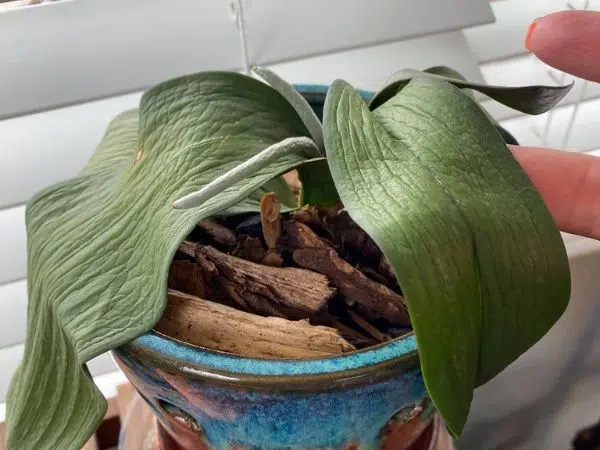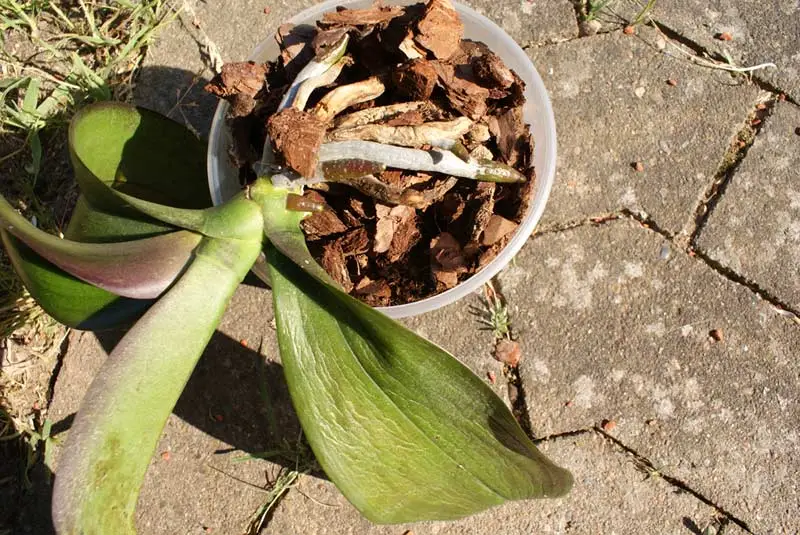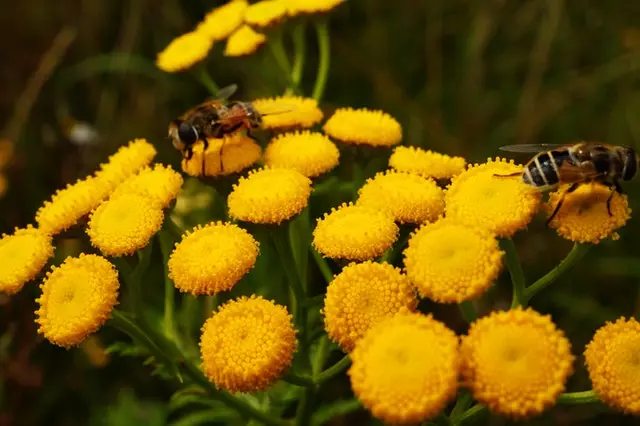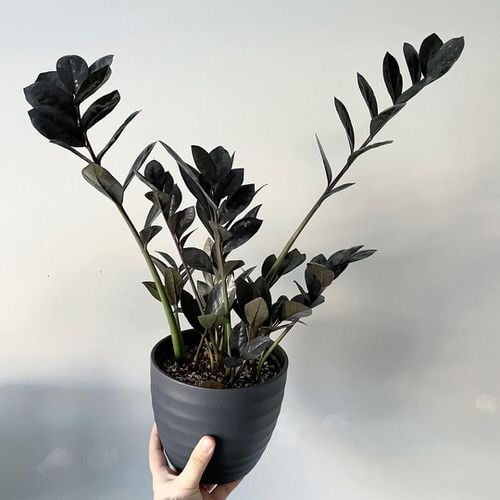When orchids are happy, their blooms are colorful, and leaves retain a uniformly green color and a rubbery texture. Mottled, discolored, and wrinkled leaves are a sign that something is wrong with your orchids. So, what causes wrinkled orchid leaves and how can you fix the plant?
Wrinkled orchid leaves are a sign of underwatering, high temperatures, damaged roots, or nutrient deficiency. To fix the plant, repot with a new potting mix, place it in a spot with bright indirect light, and water it once a week only when the top 1-2 inches of topsoil is dry.
When growing conditions that are not ideal, orchids are prone to wrinkling and will require your constant attention and care to retain their unique beauty.
Why are my orchid’s leaves wrinkled?

There are a few reasons that may cause your orchid leaves to become wrinkled. Most of the wrinkling occurs due to a lack of proper care and exposure to too much heat.
Here are the causes of a wrinkled orchid:
1. Overwatering
Orchid leaves can wrinkle because of excess water. It is especially common for indoor orchids since most growing pots lack a drainage hole where excess water can seep off with ease. If you overwater your orchid, you run the risk of causing clogging to its roots, leaching the nutrients, or changing the PH of the soil in which the plant grows.
2. Damaged roots
Damaged roots can cause your plant to wilt, wrinkle and even die regardless of the amount of water you give to the plant.
An orchid’s roots are extremely sensitive and vital for its survival. Water and other essential nutrients pass through the roots before reaching the leaves and other parts of the plant. You might accidentally cause damage to your plant’s roots during transplanting or while adjusting the growing pattern of your plant.
3. Underwatering
Underwatering your orchids can cause damage to the roots. When dehydrated, orchids start to show signs of ill health, including limp and wrinkled foliage, shrinking roots, and yellowing leaves.
You can tell if your orchid is dehydrated by looking at the behavior of the leaves. If the leaves look weak, unhealthy, and droopy, it could be that you’re not giving your plant enough water.
Although the plant can tolerate low amounts of water, the best way to fix a wrinkled orchid when dehydrated is to start watering it immediately with just enough water. You want to avoid overwatering your orchids because they can also suffer from root rot and even die.
RELATED: HOW TO REVIVE OVERWATERED ORCHID
4. Overexposure to heat
Temperatures above 75 °F are not ideal for orchids and will cause the plants to lose water to the surrounding environment fast. Leaves begin to sag at the edges, and wrinkling may occur as the plant tries to conserve the water lost.
Plants lose water to the environment through transpiration. However, the process is carefully regulated such that there remains a balance between the amount of water lost and that which is absorbed from the soil. Increasing the heat levels affects the balance negatively, causing wrinkles on the plant’s leaves.
5. Under/Overexposure to Light
Orchids prefer bright indirect light to grow happy and healthy. Bright direct sunlight will cause the plant to lose too much water and droop. Excessive sunlight is also known to bleach the chlorophyll in the leaves of orchids, leading to reduced photosynthesis. The plant will then become weak and stunted.
While orchids thrive in bright indirect light, they can also suffer when placed in a poorly lit area. A common sign of an underlit orchid plant is the yellowing of the leaves after wrinkling. You can fix light problems by placing your orchid in a spot that receives bright indirect light in your house, preferably an east-facing window.
6. Orchid disease attacks
Orchids are prone to bacterial and fungal attacks. While most attacks rarely affect the plant’s leaves, they can cause damage to the roots and stem, causing the leaves to wrinkle because of stress.
7. Poor nutrition
A lack of essential nutrients can cause your plant’s leaves to wrinkle, curl and lose quality eventually. Some soils are of poor quality and lack the required levels of zinc, potassium, and Boron to sustain the plant’s growth. These nutrients are especially useful in maintaining strong and healthy leaves.
Can wrinkled orchid leaves recover?

Wrinkled leaves can recover, but it is dependent on the underlying factors, the extent of damage, and how well you take care of your orchids during the recovery period. For example, if the leaves wrinkle because of inadequate sunlight, moving your plant to a well-lit space can help the leaves regain their original feel over time.
However, if the damage is too serious, a wrinkled leaf may not recover (and you may have to remove it before it can cause damage to the surrounding leaves). Fortunately, if you continue to take care of your plant, a new leaf might grow in its place.
How to fix and revive wrinkled orchid leaves
The right fix that will revive the wilting leaves depends on the actual cause. You want to start with some diagnosis to determine what’s causing the problem. Avoid pruning the wrinkled leaves unless they are dead or have irreparable damage.
Here’s how to fix wrinkled orchid leaves:
1. Change the potting mix
Orchid leaves might begin to curl because of using a poor quality medium in the pots. If you notice that your leaves are curling, try changing the potting mix to a Phalaenopsis potting mix that is 3 parts fir bark, 1 part perlite, and 1 part chopped sphagnum moss.
Also, some pot sizes might be too small and suffocate the roots reducing their efficiency.
2. Treat diseases and pests
Check the soil beneath for any bacterial or fungal infestation. If the plant is wrinkling, the problem could be rotting roots that cause general drooping. Get rid of the fungus with an anti-fungal treatment such as hydrogen peroxide. Make sure you sterilize the affected roots and also the pot.
Pests like aphids infest plants and as they feed on the foliage, they cause leaf curl, wrinkling, and general ill-health. If your orchid has aphids or other pests, get rid of them with pesticides or simply flush them off the plant with a garden water hose.
RELATED:
3. Water the orchid properly
Limp and leathery leaves on your orchid are a sign of water problems. Your plant probably receives inadequate amounts of water.
Here are tips on how to properly water your orchids:
- Always water your orchids in the morning as opposed to evening. Watering in the evening hours gives little room for evaporation and promotes bacterial and fungal growth.
- If you’re using a growing pot, let the water sink gently until it flows freely from the drainage holes.
- Orchids prefer water ranges above 50F. Anything colder might affect the quality of your plant.
- Do not overwater your orchids. Stick to a routine of thrice a week for outdoor orchids and once a week for indoor plants.
4. Fix affected roots
The roots can tell a lot about the health of your plant. For instance, if you find them dry and brittle, the problem could be underwatering, and adding some water could help solve the problem.
However, if they are wet, soggy, and rotting, your problem might be too much water. Try leaving the plant out in a warm place for several days without adding additional water to fix the wrinkled orchid leaves. You can also check for fungal and bacterial infections in the plant’s roots.
5. Provide indirect light
Discolorations on your plant’s leaves are primarily because of insufficient light. If the leaf color changes from green to yellow, the cause is most likely insufficient lighting. Move the plant to a well-lit area and keep it under observation until the wrinkling heals.
Orchids are great east-facing window plants. Do not expose the plant to direct sunlight for long hours. Excessive light might cause the leaves to bleach and lose their color appeal.
RELATED: PLANTS THAT ARE BEST IN EAST-FACING WINDOW
6. Apply a 20-20-20 fertilizer
Growing orchids in a pot over time can lead to the leaching of nutrients. As you water the plant, it carries vital nutrients away from the soil, leaving your orchids malnourished.
Poor nutrition might cause the leaves to change color from bright green to a darker shade or sometimes show some purple shades.
If the wrinkling is happening because of poor nutrition and soil pH problems, amend the soil to a pH level between 5.5 and 5.5. Also, feed the plant with a 20-20-20 balanced nitrogen fertilizer and then mix with water to reduce its strength a little bit before applying it into the pot to fix the wrinkled leaves.
Wrinkled vs. Healthy Leaves
It is easy to tell if an orchid leave has wrinkles or not. You can test the texture of your leaves by giving them a slight rub on the surface while placing part of the leaf between your thumb and forefinger. A wrinkled leaf feels more inelastic because of a lack of adequate water within the leaf’s interior.
You can also check the leaf for color changes on the surface, and healthy orchid leaves should have a bright green color. Any color changes should tell you that your plant is suffering from some form of stress. Color changes can include yellow, dark green to some shades of purple and black.
Here are the differences between healthy and unhealthy, wrinkled orchid leaves:
| Healthy orchid leaves | Wrinkled leaves |
| Healthy orchid leaves are firm and rubbery to the touch. | Wrinkled orchid leaves appear frail, torn, and have reduced elasticity. |
| Healthy leaves have a uniform green color with no discoloration. | Limp orchid leaves have discolorations, and uneven spots and may appear dull. |
| Healthy orchid leaves have uniform parallel veins extending across the surface of the leaf. | Wilting orchid leaves have uneven vein patterns extending to parts of the leaf. |
Ways to prevent wrinkled, limp leaves
Having a healthy orchid plant around your living space can positively affect your mood and improve the ambiance of your house. You can prevent wrinkling by ensuring that your plants are properly watered, placing your plant’s inadequate lighting, and using a high-quality medium for growing the plant.
You can also take care of the plant and constantly monitor its health. Be on the lookout for the common symptoms linked to the plant and the probable causes for them.
For example, a drainage hole can help you prevent overwatering since it drains excess water away from your orchid. It is advisable to add small doses of fertilizer regularly to ensure your orchid doesn’t miss out on important nutrients.



